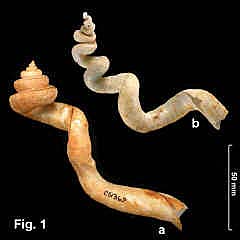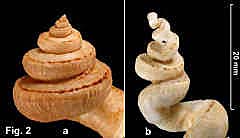|
|
|
|
|
Tenagodus australis (Quoy & Gaimard, 1834) Description: Early whorls conical and regularly coiled (Fig. 2a) or irregularly coiled (Fig. 2b); rest of shell irregularly loosely coiled or uncoiled. Whorls sculptured in part with longitudinal threads, sometimes restricted to last quarter or half of shell. Slit closed on early whorls, progressively becoming a series of elliptical holes; then open with serrated sides; then a smooth-sided slit on most of the uncoiled part of the shell; and then closed for the last few centimetres in mature shells. Aperture circular, lip thin and irregular. Interior smooth, white and polished. Colour white, fawn, grey or brown. Size: Large specimens 150 mm in length, with tube diameter 13 mm. Distribution: Endemic to Australia; central NSW, around southern Australia to at least Geraldton, south-western WA, including Tasmania. Habitat: Lives fixed to the substrate, embedded in sponge, down to about 150 m. Football sized clumps embedded in sponge have been taken in 100-150 m in southern NSW. Macpherson & Gabriel (1962, p. 103) reported a consolidated mass measuring 6 feet by 1 foot trawled in Bass Strait. Broken specimens are occasionally washed up on beaches. Comparison: This species is much larger than the other common southern Australian siliquariid, Pyxipoma weldii. Apart from size, the two may be distinguished by details of the slit. In Pyxipoma weldii, after the first few whorls, the slit is open with smooth sides along the whole length of the shell. In Tenagodus australis the slit is a series of elliptical holes in early whorls, then with ragged edge, before becoming smooth-sided on the uncoiled part. The three other large species found in NSW have a tropical distribution, with Sydney being the presently known southern limit of the range. Tenagodus ponderosus stands out because of its large size and thick tube, and its three regularly coiled whorls. Tenagodus cumingii and Tenagodus bernardii are both long and very loosely coiled, with a thinner tube than T. australis. They appear to be very similar to each other, perhaps separated by sculpture of the operculum. Stephopoma tricuspe is recognized by the lack of a either slit or series of holes. Synonymy: None Fig. 1: a. East of Ulladulla, NSW, in 119-128 m (C.051369) b. Off Merimbula, NSW, in 55 m (C.064336) Fig. 2: Same specimens as Fig. 1, enlarged to show detail. |

